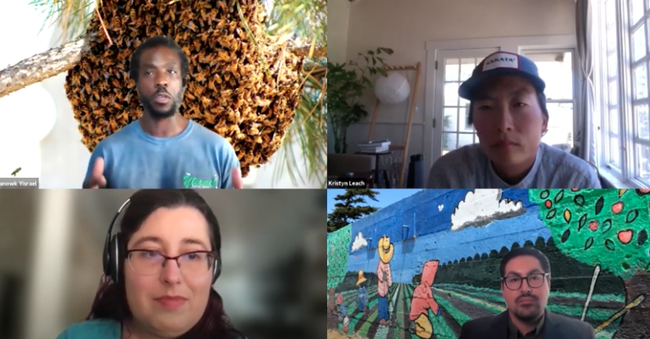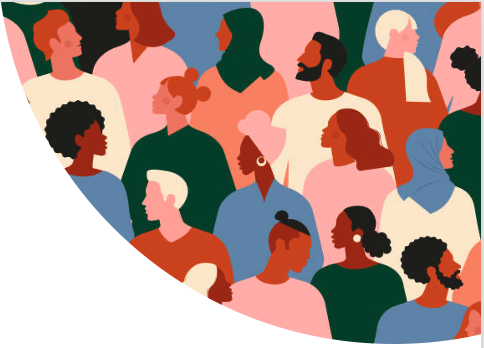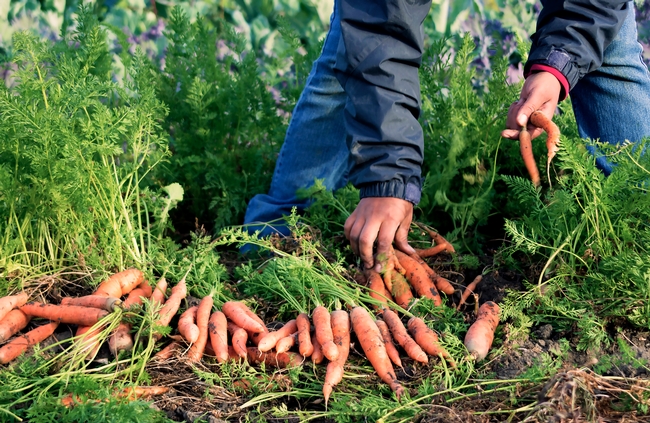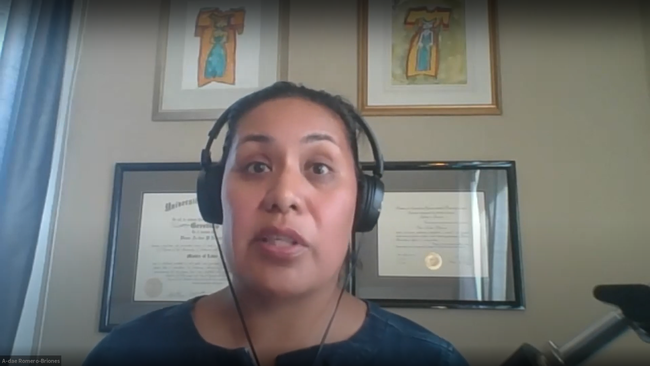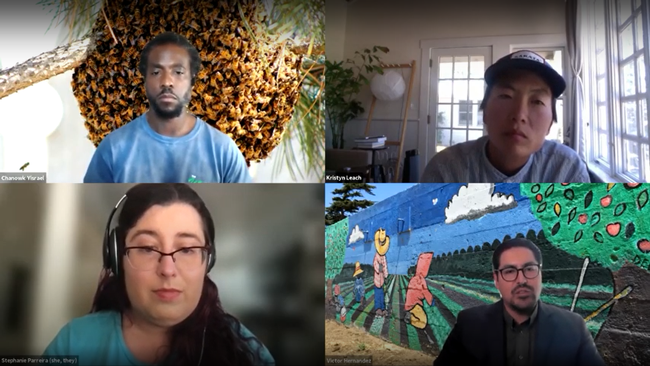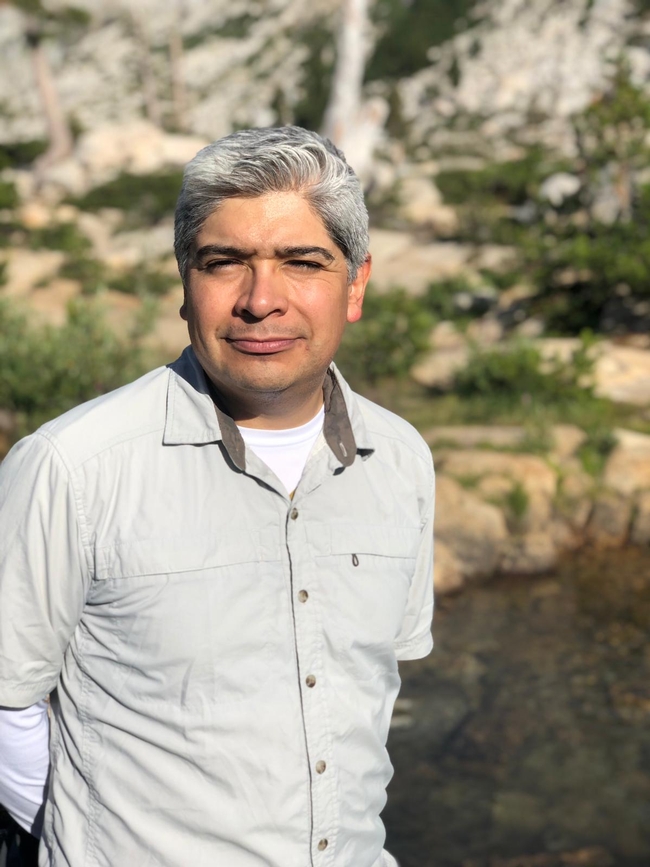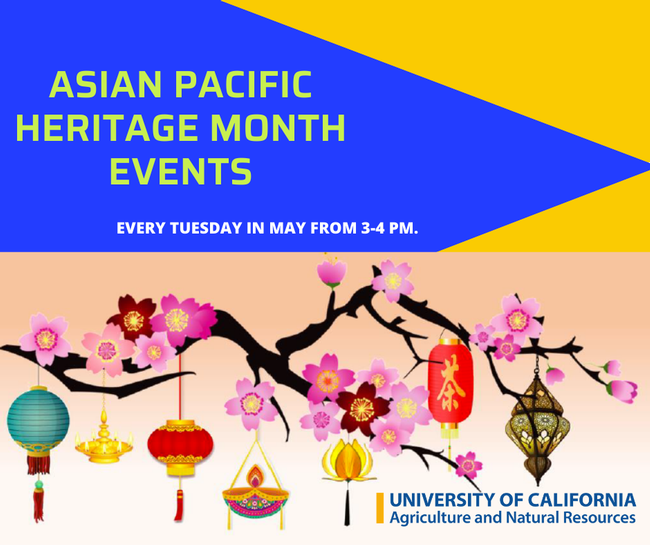Posts Tagged: diversity
Racial Equity in Extension webinar recordings available
If you missed the UC Sustainable Agriculture Research and Education Program's webinar series “Racial Equity in Extension,” you can watch the recordings. All six of the webinars are now available on UC ANR's YouTube channel in a playlist at https://www.youtube.com/playlist?list=PLLjlfxpbNglZnj700E62ZB4Gn4UoKAsYv.
In response to participants' questions, UC SAREP is providing additional reading recommendations on conducting research with Indigenous people, and guidelines for working at the interface between western science and Indigenous knowledge.
Follow-up reading:
- Exploring the Interface Between Science and Indigenous Knowledge – Mason Durie, Massey University, New Zealand
- A New Era of Indigenous Research: Community-based Indigenous Research Ethics Protocols in Canada – J. of Empirical Research on Human Research Ethics
- Protocols and Principles for Conducting Research in an Indigenous Context – University of Victoria, Faculty of Human and Social Development
For employees who are interested in collaborating with colleagues to advance diversity, equity and inclusion, UC ANR has two groups you can join:
- The Diversity, Equity and Inclusion Alliance – An opportunity to work with peers to spearhead DEI efforts organization-wide, within UC ANR. For more information, visit https://ucanr.edu/sites/deialliance/DEI_Alliance_Home/
- The Diversity, Equity, Inclusion and Justice Program Team – Gain opportunities to learn and collaborate with like-minded colleagues to improve our capacity to serve diverse external clientele across California. Contact Clare Gupta or Christy Getz for more information on how to join.
DEI Advisory Council begins work by focusing on hiring practices
The UC ANR Diversity, Equity and Inclusion Advisory Council to the Vice President has begun working to advise, support and ensure accountability for UC ANR's DEI efforts to improve working environments within UC ANR and quality of life for marginalized populations living in California.
The DEI Advisory Council focuses on inclusion and equity for individuals who have one or more marginalized identities (for example, race, national origin, class, gender, sexuality or ability).
The DEI Advisory Council members, appointed by Vice President Glenda Humiston, include
- Jairo Diaz-Ramirez
- Gail Feenstra
- Elaine Lander
- Fadzayi Mashiri
- LeChé McGill
- Esther Mosase
- Keith Nathaniel
- Laura Snell
- Katherine Soule
- Rosa Vargas
- Ricardo Vela
- Ron Walker
- Mohammed Yaghmour
All council members have completed training, finalized the council's charter, and developed and obtained approval for a workplan.
To enhance DEI in recruitment, the council partnered with the DEI Alliance Workforce Diversification Committee to review UC ANR hiring practices through a DEI lens and identify areas for improvement. They are finalizing recommendations for outreach, advertising and search committees to attract a more diverse pool of job applicants.
They presented recommended implementation steps to leadership and plan to work with Human Resources to assess the outcome of implemented recommendations and suggest additional actions as needed.
In February, they plan to host a joint meeting with the DEI Alliance to discuss group roles and purpose, collaborations and communication with the ANR community.
Farmers of color share their contributions, concerns in UC SAREP webinar series
When agricultural advisors came to the Cochiti Pueblo in New Mexico during the 1940s, they lined the irrigation ditches with concrete, in the name of boosting efficiency and productivity. But in single-mindedly focusing on water delivery, they neglected to consider how the previously inefficient seepage sustained nearby fruit trees.
Their actions, as well-intentioned as they might have been, disrupted the local ecosystem and killed the trees that had fed many generations, according to A-dae Romero-Briones, who identifies as Cochiti and as a member of the Kiowa Tribe.
“In my language, we call the extension agents ‘the people who kill the fruit trees,'” said Romero-Briones, director of the Food and Agriculture Program for the First Nations Development Institute, a nonprofit that serves Tribal communities across the mainland, Alaska and Hawaii.
The historically tense relationship between Indigenous peoples and government-affiliated programs is one of the many complex dynamics discussed in a six-part webinar series, “Racial Equity in Extension,” facilitated by UC Sustainable Agriculture Research and Education Program.
Making communities of color in the agricultural sector more visible is a priority for Victor Hernandez, a sociologist and outreach coordinator for the USDA's Natural Resources Conservation Service. Hernandez, who has organized “Growing Together” conferences for Latino and Black farmers, is trying to get more farmers of color to participate in the upcoming 2022 Agricultural Census.
“If we cannot quantify the demographic, we cannot justify the need,” emphasized Hernandez, explaining that his office uses the data to direct resources that advance equity in service, program delivery and distribution of funds.
A legacy of mistrust
At the same time, however, Hernandez also acknowledged the challenges in registering growers of color for the census, conducted by the USDA's National Agricultural Statistics Service. (According to Brodt, USDA's most recent agricultural census, dating to 2017, counts approximately 25,000 producers of color among 128,535 total producers in California.)
“Many of us that are considered socially disadvantaged or historically underserved…a lot of times our peoples come from [nations with] oppressive governments,” Hernandez said. “And so when you come to the United States and you begin to build your life here, to go and engage with the federal government is not the first knee-jerk reaction.”
On top of government mistrust and fears of deportation or detention, other immigrant groups have seen mainstream agriculture – borne by the “Green Revolution” wave across the globe – replace deep-rooted cultural practices, said Kristyn Leach of Namu Farm in Winters.
“It just makes these small farmers distrust our own knowledge, the knowledge that's existed for centuries – before the kind of current iteration of agriculture that we're situated within right now,” said Leach, who works to preserve the agricultural heritage of her Korean ancestors, and facilitates a farmers' collaborative called Second Generation that adapts Asian crop varieties to climate change.
According to Romero-Briones, a collective memory of supplanted culture also lingers in Indigenous communities. In the Cochiti Pueblo, “primarily a subsistence agriculture community” with a long history of corn cultivation, their practices are distinct from those in the mainstream – including regenerative and sustainable agriculture.
Building relationships takes commitment
Given that legacy of cultural displacement and appropriation, how do extension professionals and other agricultural advisors slowly rebuild trust with communities of color? For Romero-Briones, it begins with a genuine respect for Indigenous practices, and she urges interested people to contact their local tribal historic preservation officer to begin strengthening those connections and understanding – beyond a couple of phone calls.
“As someone who works with Indigenous people all day, even I need to recognize sometimes I have to meet with people up to 12 times before we actually start talking about the work that I initially wanted to talk to them about,” Romero-Briones said.
In a similar vein, Chanowk Yisrael, chief seed starter of Yisrael Family Farms, encouraged listeners to reach out to members of the California Farmer Justice Collaborative – an organization striving for a fair food system while challenging racism and centering farmers of color.
“To use a farm analogy: we've got this ground, which is the farmers of color who have been neglected for a long period of time,” said Yisrael, who has grown his farm in a historically Black neighborhood of Sacramento into a catalyst for social change. “It's not just going to be as simple as just throwing some seeds and things are going to come up; you're going to have to do more – that means you got to get out and do much more than you would do for any other community.”
Investing time in a community is one thing – and backing it up with tangible resources is another. Technical expertise is only the “tip of the iceberg,” Leach said, as historically marginalized groups are also seeking land access and tenure, more affordable cost of living, and access to capital.
“All of those things are actually much bigger burdens to bear for most communities of color than not having the knowledge of how to grow the crops that we want to grow, and not knowing how to be adaptive and nimble in the face of climate change," Leach explained, highlighting California FarmLink as an essential resource. (“Understanding Disparities in Farmland Ownership” is the next webinar in the SAREP series, set for Nov. 19.)
Bringing diverse voices to the table
Another key is ensuring that farmers and farm workers of color are represented in management and decision-making processes. Samuel Sandoval, a professor in the Department of Land, Air and Water Resources and UC Cooperative Extension specialist in water management, develops outreach programs in English and Spanish for everyone from farm workers to the “boss of the boss of the boss.”
“It has to be changed,” he said, “because at the end, the person who is going to operate the irrigation system and turn on or off the valves, the person who is looking if there's a leak or not – that's the person who's not being informed, or has not been informed on purpose.”
That exclusion of certain groups can lead to a loss of invaluable knowledge. Leach said there is a real danger in ignoring the wisdom of communities that have contributed so much to the foundation of food systems in California and around the globe.
“These really kind of amazing, sophisticated and elegant agroecological systems that we don't often legitimize through the scientific language and perspectives aren't seen as being really technically proficient – but, in many ways, they're more dynamic and more resilient than the things that we're perpetuating right now,” she said.
As a concrete example, Sandoval said that while extension advisors and specialists conduct studies to remedy a plant disease, farm workers might be developing – separately and in parallel – their own solutions by asking for advice from their social networks via WhatsApp, a phone application.
A reimagining of collaboration, Sandoval said, would include (and compensate) people working in the field for sharing their perspectives – bringing together academics and farmers, integrated pest management experts and pesticide applicators, irrigation specialists and those who do the irrigation.
A need to look within
Concerns about inclusion and validating alternate sources of knowledge apply also to the recruitment process in extension. Leach said that she has seen listings for advisor jobs that would require, at a minimum, a master's degree – which would automatically disqualify her, despite her extensive knowledge of Asian heirloom vegetables.
“When you look at a job description and you see ‘Asian crop specialist,' only required qualification is a master's degree, and then somewhere down the long list of sort of secondary desired, recommended things is some knowledge of Asian crops or communities…you know that just says a lot in terms of what has weight,” Leach explained.
Before organizations can authentically connect with communities of color, they should prioritize diversity in their own ranks, said Romero-Briones. First Nations Development Institute had to ensure that they had adequate representation across the many Tribes that they serve.
“Before we start looking out, we have to start looking in,” she explained, “and that means we have to hire Indigenous people who know these communities.”
For extension professionals and other members of the agricultural community in California, the UC SAREP webinar series has helped spark that introspection and a meaningful reevaluation of institutional processes and assumptions.
“These discussions have been tremendously illuminating and eye-opening,” Brodt said. “But hearing and learning is just the start – it's incumbent on us, as an organization and as individuals, to take action to ensure that farmers of color and their foodways are truly respected and valued.”
Diversity, Equity, Inclusion and Justice Program Team formed
Last month, UC ANR approved the creation of a new Diversity, Equity, Inclusion and Justice (DEIJ) Program Team. The aim of this program team is to provide a forum for networking and cross-program/cross-disciplinary dialogue on DEIJ issues that promotes learning, collaboration, and improvement in UC ANR's capacity to engage and serve diverse (in terms of race, ethnicity, ability, gender, and sexual orientation) clientele across the state, and engage all clientele in embracing the benefits diversity brings to the state as a whole. California is a multicultural state rich with a population of diverse ancestry, and as a publicly funded institution, UC ANR has the responsibility to ensure we are effectively reaching all our California communities equitably.
“We envision that the program team will serve as a formal venue for individuals and workgroups committed to integrating DEIJ into their programmatic work to connect and learn from each others' experience,” said Clare Gupta, UCCE specialist, who is leading the effort with Sonja Brodt, Academic Coordinator for the Sustainable Agriculture Research and Education Program. “It will also provide a means for colleagues new to this work to increase DEIJ capacity across ANR.”
“We anticipate that the DEIJ Program Team will complement rather than supplant participation in other program teams, given that the topic of DEIJ cuts across disciplines,” she said. “Beyond convening an annual meeting, we intend for this Program Team to serve as a vehicle for a number of other DEIJ engagement activities, training, and ‘network-smart extension' opportunities. The DEIJ Program Team will follow a collaborative leadership model, led by a rotating steering committee, with mutually agreed upon roles and responsibilities.”
If you would like to join the DEIJ Program Team, please contact Gupta at cgupta@ucdavis.edu.
Bringing DEIJ considerations to bear across the wide range of research and extension activities that take place within ANR will require a sustained, multidisciplinary, statewide effort that connects and builds on the work of those across the larger UC system who are already integrating DEIJ into their programmatic work.
The DEIJ Program Team will work together with the DEI Alliance, DEI Advisory Council, and newly formed Employment Resources Groups (ERGs) to provide a comprehensive framework for learning, collaboration, and organizational and programmatic change to improve ANR's impact in traditionally underserved communities around the state.
Celebrate Asian Pacific Heritage Month in May
Everyone in the UC ANR community is invited to join virtual events to learn, share, support and celebrate Asian Pacific Heritage Month every Tuesday in May from 3 to 4 p.m.
- May 4 - The Asian Pacific Identity: Experiences and Stories
- May 11 - Asian Pacific Farmers in California: Past and Present
- May 18 - Violence in Asian Pacific Communities: Exclusion, Internment and Hate Crimes
- May 25 - Supporting Our Friends and Colleagues: Bystander Intervention Training
The weekly events will begin May 4 with a discussion of who is included and what is meant by the terms Asian, Asian American and Pacific Islander. Surendra Dara will describe his immigration experience and Soo-Young Chin, a cultural consultant and ethnographer from Ethnoworks will present.
On May 11, we'll hear perspectives from Asian Americans involved in agriculture, starting with a video about Koda Farms and how this Japanese-American family continues to farm since starting to grow rice in 1928. Kellee Matsushita-Tseng will talk about her work with Second Generation Seeds, representation in Extension, and the current acts of hate. UC ANR's very own Sua Vang, Expanded Food and Nutrition Education Program (EFNEP) community health specialist, will talk about her experience farming and continuing connections with Southeast Asian farmers in Fresno County.
On May 18, we will review some history of violence and discrimination against Asians and Asian Americans in the U.S., then May Lin, postdoctoral fellow at the Interdisciplinary Research Institute for the Study of (in)Equality at the University of Denver, will encourage participants to think beyond the framing of individual hate crimes and more towards community approaches – such as the Black-Asian solidarity efforts in Oakland – to dismantle systemic violence.
On May 25, Advancing Justice Chicago, in partnership with Hollaback! and CAIR-Chicago, will give us a crash course in how to de-escalate harassment and support people who are targets of harassment and violence.
All of the sessions are scheduled for an hour, but speakers will remain online beyond 4 p.m. if needed to answer questions and allow for extended discussion.
Register at http://ucanr.edu/aphm2021.
The image for UC ANR's Asian Pacific Heritage Month was designed by Surendra Dara, UC Cooperative Extension entomology and biologicals advisor in San Luis Obispo, Santa Barbara and Ventura counties.
The font and colors are representative of Asian Pacific heritage. The cherry blossoms represent spring, new life and vibrancy. The lanterns symbolize light, and light represents knowledge, wisdom and education. Lanterns representing the cultures of China, Japan, Korea, Malaysia, Sri Lanka, India and Thailand are included. The shapes and colors of the lanterns are different, but the lanterns all serve the same purpose: to shine light. For UC ANR, the cherry branch represents our role in food production and natural resources while the lanterns represent our role in outreach.
Your APHM planning team:
Apurba Barman
Sibani Bose
Surendra Dara
Charles Go
Greg Ira
Pam Kan-Rice
Janice Kao
Dohee Kim
Vikram Koundinya
Elaine Lander
Tunyalee Martin
Yu Meng
Stephanie Parreira
Devii Rao
Marisa Tsai
Sua Vang
Laura Vollmer

